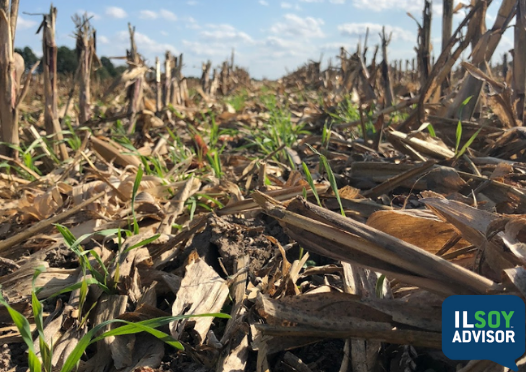ILSOYADVISOR POST
Plant & Soil Health: Back to the Basics: Details Matter for Productive Soils
When it comes to soil health, you might have to dig a little deeper, look at things from a different angle or make sure everything balances out to improve your dirt's fertility.
Certain things are known about Illinois soils, most importantly that they vary across the state. The key is to figure out what works best in your situation. And although soils vary, there are a few principles that most farmers can apply. All start with a soil test and end with patience.
"Illinois soybean farmers have a variety of options that can help improve their soil," says Roger Windhorn, resource soil scientist for Illinois Natural Resources Conservation Services (NRCS).
Soil Tests Pay Dividends
Right now, with crop prices down and high input costs, farmers will really look at soil tests a lot closer for the next two crop years, says Chris Behl of Bloomington-based Pro-Ag Consulting LLC.
"For farmers whose soils tests are recent, it's a huge advantage," he says. "You know exactly what shape your soils are in, which ones are out of balance, which ones have acute shortages and where you can prioritize your dollars to achieve a profit."
Soil tests are especially important on new ground. "You miss a lot just by windshielding it," Behl says. "Information acquired from a soil test can be used to decide which crop and varieties to plant, which fertilizers to use, and what kind of tillage practices to implement."
"The key to soil testing is how you use it. You have to follow up," says Don Guinnip, soybean farmer from Marshall, Ill., and Illinois Soybean Association (ISA) Production Committee chair.
Soil testing can be done at various times of the year, but Behl prefers right after planting. Soil conditions are ideal, farmers have time to get data analyzed and have more options for fall. As crops get taller in the summer, it is more difficult to sample. Post-harvest sampling is limited by weather and turnaround time. Either way, the key is establishing and working from a base.
"At the end of the day, people want answers before spring," says Behl, whose company provides soil and agronomy testing for Illinois farmers. "Everything else is predicated after that."
Balance pH
The most important thing to improving soil is to get the pH right and to balance the elements that contribute to pH, says Kelly Robertson, a farmer and owner of Precision Crop Services, in Benton, Ill.
Soil pH is most important for nutrient availability and is the easiest and cheapest to correct, adds Behl. "It's a building block you should look at very closely," he says.
Soil pH varies across Illinois. Prairie areas with dark-colored soils generally have a higher pH because of nutrient cycling of calcium by the grass roots. Timber areas with light-colored soils generally have a lower, more acidic pH because of the presence of organic acids in the leaf litter that cause greater leaching of the soil, says Windhorn.
Applying limestone is necessary to adjust soil pH, and lime quality matters. So does application. Robertson finds that the cheapest lime may be coarse or not apply well due to an inconsistent grind. This also leads to a lime not breaking down well in the soil. Robertson says all lime is different, so invest the time to find the best one for your situation.
Organic Matter Matters
"One of the best things any Illinois farmer can do is to add or protect organic matter in their soil," Windhorn says. Since residue quantities are minimal in soybeans, it is very important to keep what is there.
This is one reason Guinnip likes double-crop soybeans and cover crops. His timber soils are low in organic matter and high in clay. The winter wheat and cover crops he plants improve the root systems for other crops, hold nutrients in place, stop erosion and increase the organic matter.
"It’s a lot of little things that add up and pay for the expense to plant the crop," he says.
A good, healthy soil has a lot of organic residues that are breaking down and converting to organic matter, Robertson says. If farmers have access to manure, applying it can increase organic matter and add nutrients.
Large amounts of surface residue do not equal a large increase in soil organic matter. Building organic matter takes time, lots of time, Robertson notes. He says farmers can't just plant a cover for a couple years and expect an increase in soil organic matter from two to three percent.
Organic matter, which is higher in Prairie soils, helps serve as a shock absorber, too. Low organic matter clay timber soils in southern Illinois tend to stick together more.
Soil Structure is Foundation
Remember seeing soybeans standing in water last year? Odds are those beans took a yield hit.
Behl says when corn or beans don't get off to a good start, it's hard to come back from a high rainfall unless farmers get rid of the excess water.
Soil structure destroyed this year will contribute to yields next year, confirms Robertson. "Farmers want to make sure they don't do anything to restrict root growth," he says.
Good soil structure develops over long periods of time with freezing and thawing, wetting and drying, and is influenced by plant roots and microbes.
"We can and do alter structure, usually in a bad way, with over tillage, lack of cover crops, hard pan development and compaction," Windhorn says.
Sometimes farmers can't change the soil, but they can manage it by understanding it, Behl says. One practice that can help soil health and drainage is to have a plan to build and not destroy soil structure. Write the plan down and follow it. Know what fields flood, which tend to stay wet, how they should be tilled, which direction they should be planted and even where trucks should park during harvest, adds Robertson. Don't do anything that would destroy good soil structure.
Fertility Counts
From a fertility standpoint, farmers really must monitor potash in southern Illinois, advises Robertson. Potash levels are easier to lose than gain. And in a soil testing program, potash may not change from year to year, even when potash is applied at higher rates.
This doesn't mean farmers should ignore potash. "The tendency is to think that I can't build it so I won't put it on," says Robertson. "But if you quit, test levels will go down faster than they come in.”
"As the economy changes and margins tighten, it is more important than ever to put the fertilizer investment where plants need it," Guinnip says.
So if you haven't had a soil test in four or five years, it's probably time for a checkup. "Look at the crop removal each year," Behl explains. "We had an exceptional crop in 2014, but we haven't seen the huge nutrient removal rates we thought were out there."
Illinois farmers have seen a lot of variable rainfall the past few years, from droughts to floods, which Robertson says makes predicting nutrient removal rates challenging to predict.
Invest the Time
Investment in improving soil fertility, soil structure and soil health is a long-term commitment. Farmers are pressed for time but a lot of things they are dealing with, such as fertility, structure, organic matter and water, are things that previous generations of farmers also managed, only perhaps on a smaller scale, Robertson says.
Now we have technology that makes it easier to manage things like cover crops, Guinnip says.
"We all have to keep in mind, though, that because the soil is highly buffered, it slowly resists changes and sometimes a significant period of time is necessary before improvements become noticeable," Windhorn says. "Patience is the key word."
Checkoff Fact: More Information is Available
For more soil insights from Roger Windhorn, resource soil scientist for Illinois Natural Resources Conservation Services (NRCS), visit ilsoyadvisor.com, the Illinois soybean checkoff management site that offers current tips and information to enhance profitability.
Textbox
NRCS joins groups across the world to celebrate the International Year of Soils in 2015. The 68th session of the United Nations General Assembly designated 2015 for the yearlong soils celebration as a way to increase understanding of the importance of soil for food security and essential ecosystem functions.
This article originally appeared in the February issue of Illinois Field & Bean.




Comments
Add new comment